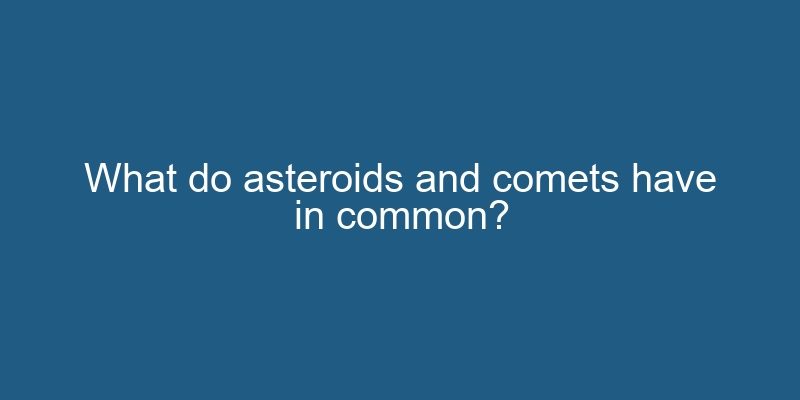Asteroids and comets are two types of celestial objects that orbit the Sun. While they may appear similar at first glance, there are significant differences between the two. However, they also share several similarities. In this article, we will explore the common characteristics of asteroids and comets and delve into their unique features.
1. Origins
Asteroids and comets both originated from the early solar system, which formed approximately 4.6 billion years ago. They are remnants of the material that did not accrete into planets during the formation of the solar system.
1.1 Asteroids
Asteroids are rocky objects that primarily reside in the asteroid belt, a region located between the orbits of Mars and Jupiter. They are composed mainly of rock and metal, and their sizes range from small boulders to objects several hundred kilometers in diameter.
1.2 Comets
Comets, on the other hand, originate from the outer regions of the solar system, such as the Kuiper Belt and the Oort Cloud. They are composed of a mixture of rock, dust, ice, and organic compounds. Comets are typically larger than asteroids, with sizes ranging from a few kilometers to tens of kilometers in diameter.
2. Orbits
Both asteroids and comets orbit the Sun, but they follow different paths due to their distinct origins.
2.1 Asteroids
Asteroids have more predictable and stable orbits compared to comets. They generally follow elliptical or nearly circular paths within the asteroid belt. However, some asteroids can have eccentric orbits that cross the paths of other planets, making them potentially hazardous to Earth.
2.2 Comets
Comets have highly elliptical orbits that can take them far away from the Sun and then bring them back towards it. When a comet approaches the Sun, the heat causes its icy nucleus to vaporize, creating a glowing coma and a tail that points away from the Sun due to solar wind. Some comets have extremely long orbital periods, taking hundreds or even thousands of years to complete a single orbit.
3. Composition
The composition of asteroids and comets differs significantly, which is reflected in their appearance and behavior.
3.1 Asteroids
Asteroids are primarily composed of rocky and metallic materials. They can be classified into different groups based on their composition, such as carbonaceous, silicate, and metallic asteroids. The presence of various minerals and metals gives asteroids their characteristic appearance.
3.2 Comets
Comets consist of a mixture of rock, dust, ice, and organic compounds. When a comet approaches the Sun, the heat causes the ice to sublimate, creating a glowing coma and a tail composed of dust and gas. The sublimation of ice is responsible for the spectacular displays associated with comets.
4. Impact on Earth
Both asteroids and comets have the potential to collide with Earth, with potentially catastrophic consequences.
4.1 Asteroids
Asteroids are more likely to collide with Earth due to their higher abundance and the proximity of the asteroid belt to our planet. When an asteroid enters Earth’s atmosphere, it becomes a meteoroid. Most meteoroids burn up upon entry, creating bright streaks of light known as meteors. However, larger meteoroids can survive the atmospheric entry and impact the Earth’s surface, causing significant damage.
4.2 Comets
Comets pose a lesser threat to Earth compared to asteroids. Due to their highly elliptical orbits, comets rarely intersect with Earth’s orbit. However, if a comet were to collide with Earth, the impact could release an enormous amount of energy due to its high speed and mass. This could result in widespread devastation.
5. Exploration
Both asteroids and comets have been the subject of exploration by various space missions.
5.1 Asteroids
Several spacecraft, such as NASA’s NEAR Shoemaker and Japan’s Hayabusa missions, have visited asteroids to study their composition, structure, and origin. These missions have provided valuable insights into the nature of asteroids and their role in the formation of the solar system.
5.2 Comets
Comets have also been targets of exploration. In 2014, the European Space Agency’s Rosetta mission successfully landed a probe on a comet’s surface for the first time in history. The mission provided unprecedented data about the composition and structure of comets, shedding light on their role in the early solar system.
6. Future Implications
Understanding the similarities and differences between asteroids and comets is crucial for future space exploration and the potential mitigation of impact hazards.
6.1 Asteroids
Asteroids have been identified as potential targets for future mining operations. Some asteroids contain valuable resources, such as metals and water, which could be utilized for space exploration and colonization. Additionally, studying asteroids can provide insights into the early history of the solar system.
6.2 Comets
Comets, with their rich composition of organic compounds and water ice, are believed to have played a crucial role in the origin of life on Earth. Further exploration of comets could provide valuable clues about the building blocks of life and the possibility of extraterrestrial life elsewhere in the universe.
Conclusion
While asteroids and comets have distinct characteristics, they also share commonalities. Both originated from the early solar system, orbit the Sun, and have the potential to impact Earth. Understanding their composition and behavior is essential for future space exploration and the mitigation of impact hazards. By studying these celestial objects, scientists can gain valuable insights into the formation and evolution of our solar system.

